Removal Procedure
Tools Required
| • | J 24402-A Glass
Sealant (Cold Knife) Remover |
| • | J 39032 Liftgate
Glass Removal Tool |
| • | Ispropyl alcohol or equivalent |
| • | Cartridge-type caulking gun |
| • | Commercial-type utility knife |
- Unclip the defogger connector at the left and right side of the
window from the inside of the cab, if equipped.
- Remove all trim panels necessary in order to gain access for rear
window removal.
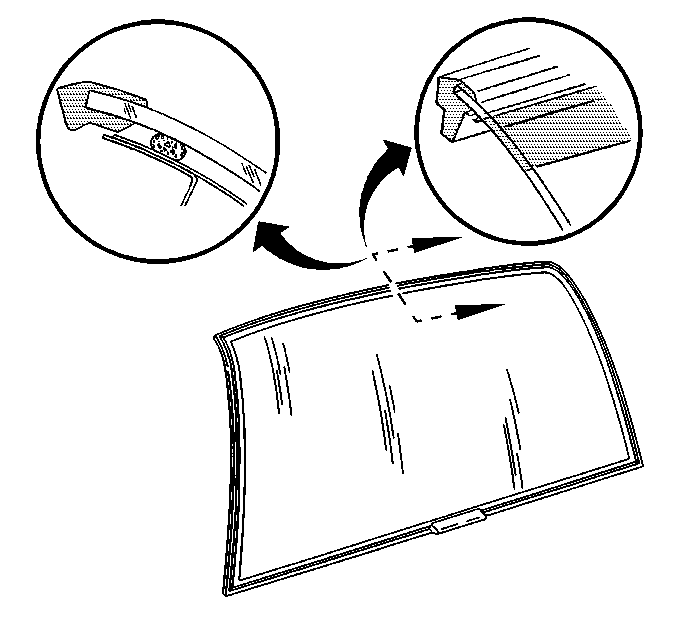
- Use theJ 39032
from the inside of the window and J 24402-A
from outside to remove
the glass assembly from the window frame.
- With an assistant standing outside of the vehicle, push the window
out from the vehicle.
Important: Keep the cutting edge of the tool against the window when removing.
This will allow the urethane adhesive to be separated from the window. The
only suitable lubrication is clear water.
- UseJ 24402-A
or J 39032
in order to cut
the window from the pinchweld flange. Do this from inside the vehicle.
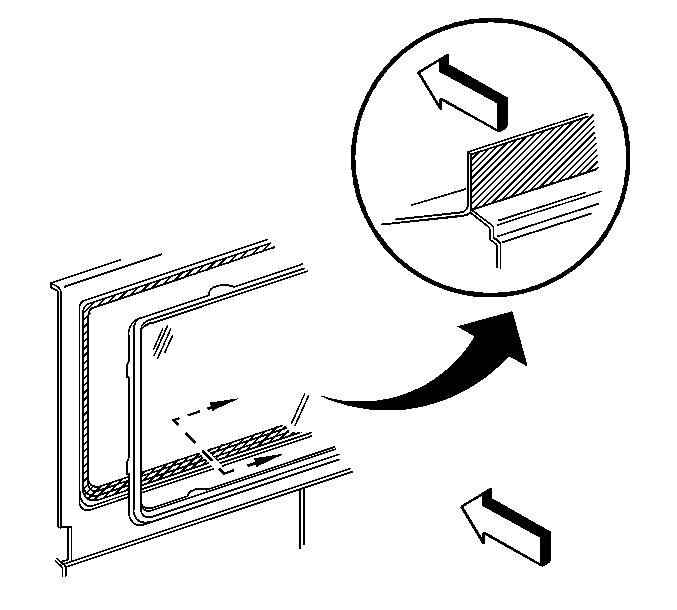
- Remove the liftgate window
from the pinchweld flange with the aid of an assistant.
- Look for any of the following problems in order to help prevent
future breakage of the window:
- The following components may reveal the causes of a broken window:
| • | The flange of the window opening |
| • | The liftgate window reveal molding |
- Look for any of the following problems in order to help prevent
future breakage of the liftgate window:
| • | Hardened spot weld sealer |
| • | Any other obstruction or irregularity in the pinchweld flange |
Important: If corrosion of the pinchweld flange is present, or if sheet metal repairs
or replacements are required, the pinchweld flange must be refinished in order
to restore the bonding area strength.
- If paint repairs are required, mask the flange bonding area prior to
applying the color coat in order to provide a clean primer only surface. Using
materials such as BASF DE17 ®, DuPont 2610 ®,
Sherwin-Williams PSE 4600 and NP70 ® and Martin-Senour
5120 and 5130 ® products are approved for this application.
After repairing the open as indicated, perform the following steps:
- Inspect the condition of the window opening and the adhesives
bead to determine which installation method should be used. Refer to
Short Method Description
short
method or
Extended Method Description
extended method for guidelines.
- Remove no more of the urethane adhesive than necessary in order
to maintain the original shape. This will ensure the proper clearance between
the window and the pinchweld flange of the opening.
- Clean around the edge of the inside surface of the window with
one of the following cleaners:
| • | GM Glass Cleaner P/N 1050427 |
| • | A clean isopropyl alcohol dampened cloth |
- Remove the liftgate reveal molding from the edge of the window.
The liftgate window reveal molding retains the urethane adhesive in
the cavity between the body and the opening.
Installation Procedure
After repairing the opening as indicated, perform the following:
Caution: When working with any type of glass or sheet metal with exposed or rough
edges, wear approved safety glasses and gloves in order to reduce
the chance of personal injury.
Caution: Failure to prep the area prior to the application of primer
may cause insufficient bonding of urethane adhesive. Insufficient bonding
of urethane adhesive may allow unrestrained occupants to be ejected from
the vehicle resulting in personal injury.
- Shake the pinchweld primer (black #3) for at least one
minute.
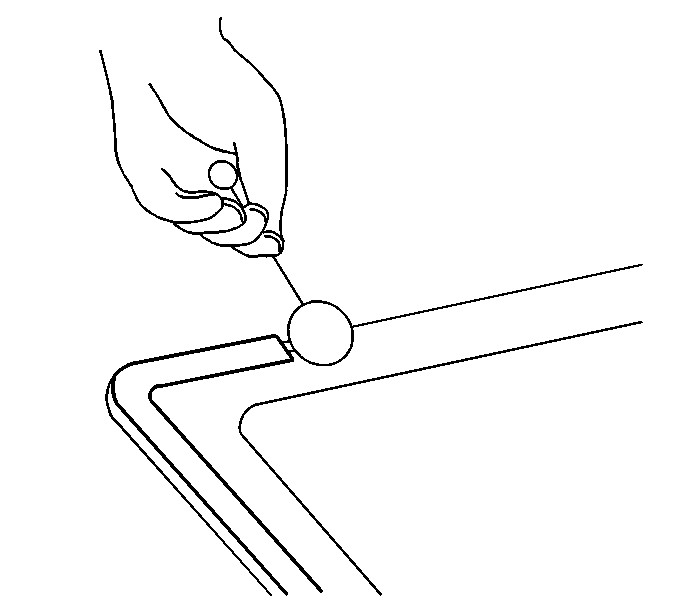
- Use a new dauber to apply
the pinchweld primed (black #3) to the surface of the bonding area.
- Allow the primer to dry for approximately 10 minutes, also check
to ensure that all nicks and scratches are cover.
- Install the liftgate window reveal molding to the edge of the
window. If the original reveal molding is damaged it must be replace.
If the liftgate window reveal molding is damaged by cutting it too
close to the window surface, replace the window.
- With the aid of an assistant, dry fit the liftgate window into
the opening in order to determine the correct way to position the liftgate
window in the opening.

- Use masking tape in order
to mark the location of the liftgate window in the opening.
- Slit the masking tape at the top edge of the liftgate window.
- Remove the liftgate window from the opening.
- Place the liftgate window inside up on a clean, protected surface.
- If the original window is being reused, remove all but a thin
film of the existing urethane adhesive from the window surface using a clean
utility knife or razor blade scraper.
- Clean the inside surface of the liftgate window with GM Glass
Cleaner P/N 1050427.
Caution: When working with any type of glass or sheet metal with exposed or rough
edges, wear approved safety glasses and gloves in order to reduce
the chance of personal injury.
Caution: When replacing stationary windows, use Urethane Adhesive Kit GM P/N 12346392
(Canadian P/N 10952983), or a urethane adhesive system meeting GM Specification
GM3651G, to maintain original installation integrity. Failure to use the urethane
adhesive kit will result in poor retention of the window which may allow unrestrained
occupants to be ejected from the vehicle resulting in personal injury.
- If the extended method is being used remove
all but approximately 2 mm (3/64 in) of the existing bead
of adhesive from the pinchweld flange.
Important: Do not remove all traces of the adhesive. Remove all mounds or loose
pieces of urethane adhesive.
- Shake the pinchweld primer (black #3) for at least one minute.
- Use a new dauber to apply the primer to the surface of the pinchweld
flange.
- Allow the glass primer to dry for approximately 10 minutes.

Important: Use care when applying the glass prep (clear #1) in order to
prevent the window prep from running into the vision area of the window.
This primer dries almost instantly, but may stain the viewing area
of the window if not applied evenly.
- Use a new dauber in order to apply glass prep (clear #3) to the
area approximately 10 mm to 6 mm (3/8 in to 5/8 in).
around the entire perimeter of the window inner surface.
- Apply a second coat of the glass prep number (clear #1)
to the same area of the glass.
- Wipe the glass primed area immediately with a clean lint free
cloth.
- Shake the glass primer (black #2) for at least one minute.

- Use a new dauber in order
to apply the glass primer (black #2) to the same areas that glass prep
(clear #1) was applied.
The glass primer (black #2) is good up to 8 hours after applying
it to the glass. The primed surface of the glass must be kept clean.
- Allow the glass primer to dry for approximately 10 minutes.
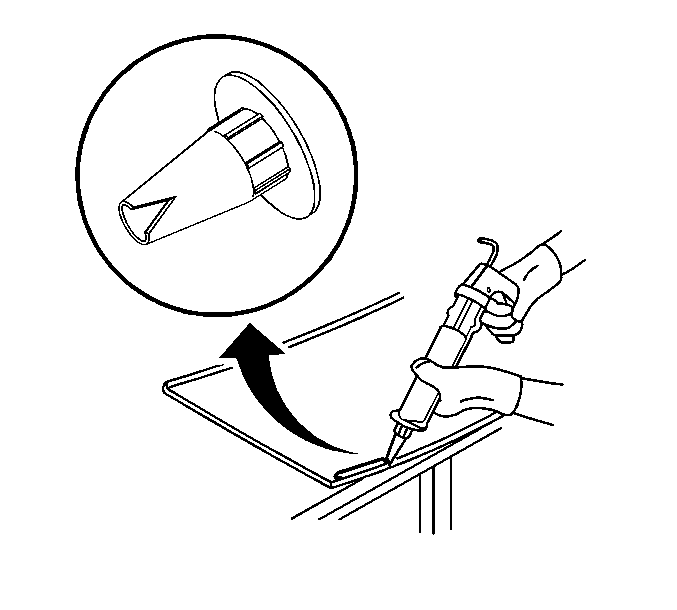
- If using the short method,
of cut the tip of the nozzle to provide an adhesive bead of 6.0 mm (1/4 in ).
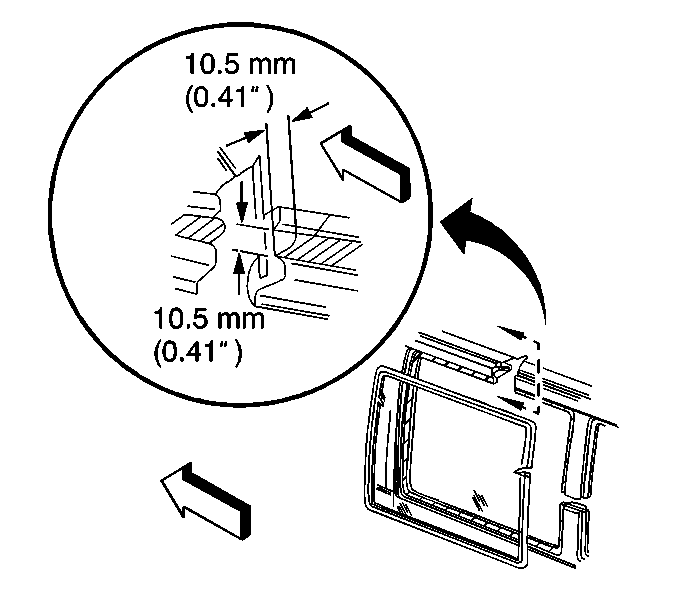
- If using the extended
method, cut the tip to provide an adhesive bead of approximately 10.5 mm
(0.14 in ) wide and 10.5 mm (0.14 in ) high.
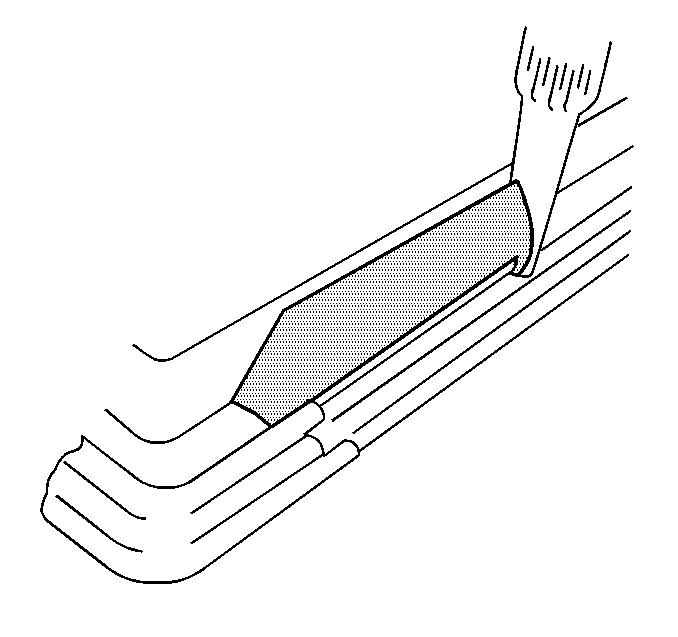
- Use a cartridge type caulking
gun, to apply a smooth continuous bead of urethane adhesive.
- If reusing the original glass apply the new urethane adhesive
on the top of the fresh trimmed urethane adhesive.
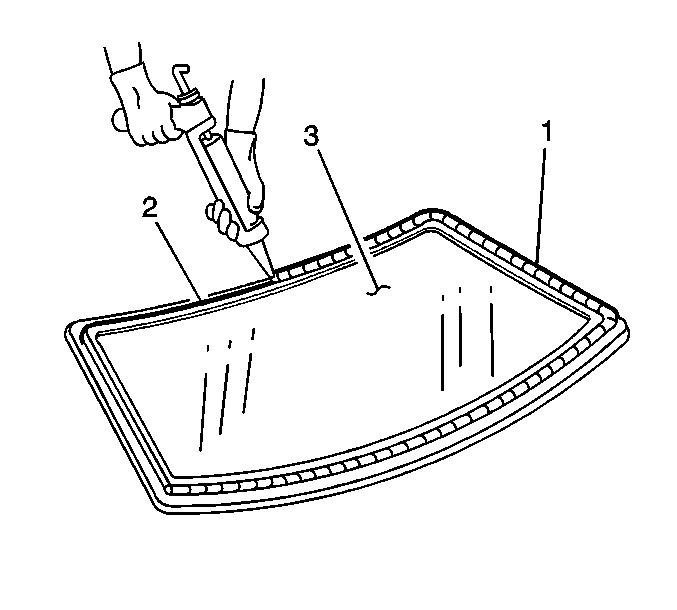
- If installing a new glass
(3) apply the urethane adhesive (1) to the freshly primed pinchweld flange.
If applying urethane adhesive to the inside edge of the window use the
window reveal molding as a guide for the nozzle.
- Use suction cups, and with the aid of an assistant, install the
liftgate window into the opening.
- Align the tape on the liftgate window and the body.
- Press the liftgate window firmly into place.
- Tape the liftgate window to the body in order to minimize movement.
| 30.1. | Clean any excess urethane adhesive from the body. |
| 30.2. | Use a soft spray of water in order to watertest the liftgate window
immediately. |
| 30.3. | Do not direct a hard stream of high pressure water at fresh urethane
adhesive. |
| 30.4. | Warm or hot water is preferred in order to accelerate the cure
of adhesive. |
Caution: When working with any type of glass or sheet metal with exposed or rough
edges, wear approved safety glasses and gloves in order to reduce
the chance of personal injury.
Caution: At least 24 hours are required for complete curing of repair
material. The repair area should not be physically distrubed until after that
time. Insufficient curing of urethane adhesive may allow unrestrained occupants
to be ejected from the vehicle resulting in personal injury.
- Inspect the window for
leaks:
If any leaks are found, use a plastic paddle in order to apply extra
urethane adhesive at the leak point.
- Retest the window for leaks.
Important: Use the following procedure in order to properly cure the urethane adhesive.
| • | Allow the vehicle to remain at room temperature 21°C or (70°F)
at 30 percent relative humidity. |
| • | Allow a minimum of 6 hours for the moisture curing urethane
adhesive. |
| • | Allow a minimum of 1 hour to 1 1/2 hours for the chemical
curing urethane adhesive. |
| • | Partially lower a door window in order to prevent pressure buildups
when closing doors before the urethane adhesive cures. |
| • | Do not drive the vehicle until the urethane adhesive is fully
cured. |
- Do not use compressed air in order to dry the urethane adhesive.
- Connect the defogger clips on each side of the window on the inside
to the body connectors, if equipped.
- Install all trim panels which were removed in order to gain access
for rear window removal.
- Ensure that the two tabs on the bottom of the window are positioned
in the slots on the body before installing the sliding window.










